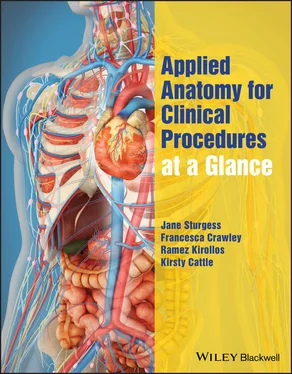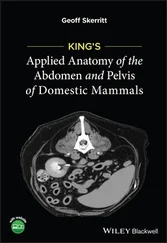29 27 Paracentesis Indications Equipment (Figure 27.1) Pre‐procedure Procedure Post‐procedure Complications
30 28 Knee aspiration Equipment (Figure 28.1) Indications Procedure Aftercare Common anatomical pitfalls (Figure 28.3) Anatomical top tips
31 29 Skin biopsy Equipment (Figure 29.1) Indications Procedure Anatomical pitfalls Top tips
32 30 Basic suturing Equipment (Figure 30.1) Choice of suture Factors determining the choice of sutures and needles Technique Variations in suturing techniques Removal of sutures Anatomical pitfalls
33 31 Basic anastomotic techniques Equipment (Figure 31.1a–c) Technique Types (Figure 31.2) Anatomical pitfalls: Bowel Anatomical pitfalls: Vascular Aftercare: Bowel Aftercare: Vascular
34 32 Abscess drainage and debridement Equipment (Figure 32.1) Procedure (Figure 32.2) Aftercare Pitfalls Anatomical top tips
35 33 Bag mask ventilation (adults) Equipment (Figure 33.1) Technique (Figure 33.2) Aftercare Common anatomical pitfalls Top tips
36 34 Endotracheal intubation (adults) Equipment (Figure 34.1) Technique Aftercare Common anatomical pitfalls Top tips
37 35 Needle cricothryoidotomy (adults) Equipment (Figure 35.1) Technique Aftercare Common anatomical pitfalls Top tips
38 36 Surgical cricothyroidotomy Equipment Indications Contraindications Procedure (Figure 36.2) Aftercare Common anatomical pitfalls Top tip
39 37 Defibrillation Equipment (Figure 37.1) Technique Aftercare Common anatomical pitfalls Top tips
40 38 Spinal injection Equipment (Figure 38.1) Technique Aftercare Common anatomical pitfalls Top tips Difficulty aspirating CSF Safety (Figure 38.5)
41 39 Epidural injection Equipment (Figure 39.1) Technique Aftercare Common anatomical pitfalls Top tips
42 40 Procedure‐related safety The problem Definitions (as per the World Health Organisation) The response Responsibilities for National Health Service (NHS) and staff Top tips (from the World Health Organisation) References Additional reading
43 Index
44 End User License Agreement
1 Chapter 1 Figure 1.1 Equipment. Figure 1.2 Before scrubbing, don hat, mask, eye protection. Figure 1.3 Recommended handwashing technique. Figure 1.4 Procedure. (a) Wash hands and arms three times (b) rinsing from f...
2 Chapter 2 Figure 2.1 Equipment. Figure 2.2 Apply the antiseptic to the operating field in a radial or concen... Figure 2.3 Cover the edges of the operating field with sterile drapes, adher... Figure 2.4 Use of an antiseptic impregnated incise drape reduces surgical si... Figure 2.5 Use sterile drapes to cover an operating trolley on which operati...
3 Chapter 3 Figure 3.1 Three‐way tap. Note the arrows on the limbs to indicate flow of f... Figure 3.2 Equipment. Three‐way taps come individually or incorporated with ... Figure 3.3 Different possible positions of a three‐way tap and combinations ...
4 Chapter 4 Figure 4.1 Image to show the possible types of needle tip and position of th... Figure 4.2 Butterfly needles. Note the needle length and injection port (whi... Figure 4.3 Spinal needles. Note the difference in needle diameter for each c... Figure 4.4 Cannulas. Note the difference in needle diameter and length for e... Figure 4.5 Syringes. Note the different tips of the 60 mL syringes. From lef... Figure 4.6 Urinary catheters. From top to bottom 3 way, 2 way, Curved or Cou... Figure 4.7 Urinary catheter bags. The most commonly used bag in hospital has... Figure 4.8 Commonly used blood bottles. Figure 4.9 Blood culture bottles. Figure 4.10 Sample pots. The white capped pot is suitable to collect most sa... Figure 4.11 Simple dressing pack, often used for small procedures. Figure 4.12 Large sterile pack, for central lines and more invasive procedur...
5 Chapter 5Figure 5.1 Local anaesthetics.Figure 5.2 Skin layers.Figure 5.3 Field block.Figure 5.4 Digital block.Figure 5.5 Supraorbital nerve block.
6 Chapter 6Figure 6.1 The GMC provides advice on consent, available on their website: h...Figure 6.2 Consent forms. Choose the correct form for the procedure and pati...Figure 6.3 Decision making with regard to obtaining consent and which form t...
7 Chapter 7Figure 7.1 A simple manometer line.Figure 7.2 Standard CSF manometer line; note the hollow tube, connected to t...Figure 7.3 Standard CVP manometer line showing the continuous column of flui...Figure 7.4 CSF manometer and three‐way tap setup.Figure 7.5 Equipment required for CVP.
8 Chapter 8Figure 8.1 Setting up the irrigation set. The set is primed from a single ir...Figure 8.2 Attaching the irrigation and catheter bag to the catheter. (a) At...Figure 8.3 The entire irrigation set‐up. (a) Open the flow switches on the p...
9 Chapter 9Figure 9.1 Equipment.Figure 9.2 (a) single, (b) double, (c) triple chamber underwater seals. The ...Figure 9.3 Attaching the drain to the seal.Figure 9.4 The complete set‐up.
10 Chapter 10Figure 10.1 Equipment required.Figure 10.2 Patient positioning and draping.Figure 10.3 Insertion of the catheter. Holding the penis in your non‐dominan...Figure 10.4 Male urethral anatomy.
11 Chapter 11Figure 11.1 Equipment required.Figure 11.2 Patient positioning.Figure 11.3 Female perineal anatomy.Figure 11.4 Female pelvic anatomy.
12 Chapter 12Figure 12.1 Equipment required.Figure 12.2 Anatomy of the radial artery at the wrist.Figure 12.3 Allen’s test. (a) Anatomy of the superficial and deep palmar arc...Figure 12.4 Brachial artery anatomy.Figure 12.5 Femoral artery anatomy.
13 Chapter 13Figure 13.1 Equipment required.Figure 13.2 Chest lead positions.Figure 13.3 Surface anatomy of the heart.
14 Chapter 14Figure 14.1 Equipment.Figure 14.2 Sagittal anatomy of the upper airway.Figure 14.3 Technique oropharyngeal airway: (a) size the airway, (b) open th...Figure 14.4 Soft tissue trauma following poorly inserted oropharyngeal airwa...
15 Chapter 15Figure 15.1 Equipment.Figure 15.2 Technique nasopharyngeal airway: (a) size the airway, (b) making...Figure 15.3 Sagittal anatomy of correctly placed nasopharyngeal airway.
16 Chapter 16Figure 16.1 Different LMAs.Figure 16.2 Patient position for insertion of LMA (plus sagittal anatomy).Figure 16.3 How to hold the LMA.Figure 16.4 Anatomical position of a correctly positioned LMA.Figure 16.5 Soft tissue trauma following poorly inserted LMA.
17 Chapter 17Figure 17.1 Equipment required.Figure 17.2 Patient positioning.Figure 17.3 Procedure – see text for explanation.Figure 17.4 Internal jugular landmarks.Figure 17.5 Chest X‐ray showing central venous catheter in correct position....
18 Chapter 18Figure 18.1 Equipment required.Figure 18.2 Patient positioning.Figure 18.3 Procedure.Figure 18.4 Internal jugular landmarks.Figure 18.5 Chest X‐ray showing central venous catheter in correct position....
19 Chapter 19Figure 19.1 Equipment required.Figure 19.2 Patient positioning.Figure 19.3 Procedure.Figure 19.4 Subclavian vein landmarks.Figure 19.5 Chest X‐ray showing central venous catheter in correct position....
20 Chapter 20Figure 20.1 Equipment.Figure 20.2 Patient position.Figure 20.3 Lead position.Figure 20.4 Synchronising the cardioverter.Figure 20.5 Charging the cardioverter.Figure 20.6 ECG pre DC cardioversion.Figure 20.7 ECG post successful DC cardioversion.
21 Chapter 21Figure 21.1 Equipment.Figure 21.2 Patient positioning and “window of safety”, bordered by pectoral...Figure 21.3 Thoracic anatomy. Note the position of the neurovascular bundle ...
22 Chapter 22Figure 22.1 Equipment.Figure 22.2 Patient positioning and ‘window of safety’. Aspiration can be pe...Figure 22.3 Connection of cannula to three‐way tap and syringe with position...Figure 22.4 Thoracic anatomy. Note the position of the neurovascular bundle ...
23 Chapter 23Figure 23.1 Equipment.Figure 23.2 Different NG types.Figure 23.3 Patient position.Figure 23.4 Estimate the length of insertion by holding the nasogastric tube...Figure 23.5 Chest X‐ray showing NGT in correct position, tip going below dia...
Читать дальше












